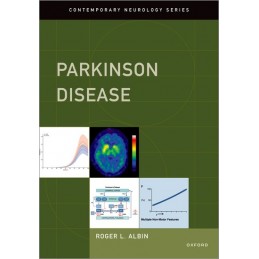Opis
Parkinson Disease is a comprehensive introduction to the biology and clinical features of Parkinson disease (PD). This book is aimed at clinicians in training, general neurologists seeking a useful guide to PD, and scientists seeking an overview of clinical aspects of PD. Topics covered include nosology of PD, PD epidemiology, pathology and pathophysiology of PD, and theories of PD pathogenesis. Clinical features, including the many non-motor features, natural history of diseaseprogression, clinical pharmacology, and management of PD receive coverage. Important themes are heterogeneity of PD, the multi-focal nature of PD pathology, the diversity of clinical features, dopaminergic signaling and the impacts of dopaminergic deficiency, the importance of non-motor features,limitations of existing treatment modalities, and the necessity of approaching PD as a multi-system disorder. The description and discussion of the many aspects of Parkinson disease (PD) is dogged by the fact that PD is an ambiguous concept. This book intends to be a useful overview, bridging the gap between general textbooks and specific topical reviews.
Szczegóły produktu
Indeks
93765
EAN13
9780190843014
ISBN
9780190843014
Opis
Rok wydania
2022
Numer wydania
1
Oprawa
twarda
Liczba stron
304
Wymiary (mm)
178 x 254
Waga (g)
862
Chapter 1: Definition, History, Nosology, and Classification; Introduction and Definition; Brief History of PD; Nosology and Classification Scheme; Classification Level 1; Classification Level 2; Ambiguities and Future Directions; Conclusion; Chapter 2: Epidemiology; Introduction; Prevalence; Incidence; Mortality; Risk Factors; Implications for Understanding Etiopathogenesis and the Future Burden of PD; Chapter 3: Pathology; Introduction; The Aging Brain; Gross Pathology, Lewy Pathology, and a-Synucleinopathy; Substantia Nigra Pars Compacta Pathology; Idiopathic Lewy Body Disease (iLBD); The Braak et al. Staging System; Synucleinopathy Outside the Brain; Non-Synuclein Pathologies; Chapter 4: Pathophysiology I - Basal Ganglia Architecture and the Standard Model; Introduction; Basic Basal Ganglia Architecture; The Standard Model of Basal Ganglia Pathophysiology; Complexities of Basal Ganglia Architecture; Conclusion; Chapter 5: Pathophysiology II - Neurotransmitter System Dysfunctions; Introduction; Nigrostriatal Dopamine Signaling Functions; Habit Formation and Chunking; Cholinergic Projection System Dysfunctions; Serotoninergic System Dysfunctions; Conclusions and Future Challenges; Chapter 6: Genetics of Parkinson Disease; Introduction; Dominant Forms of PD; Recessive Forms of PD; GBA; PD Genetic Risk Factors; Implications of PD Genetic Research; Chapter 7: Pathogenesis; Neuronal Vulnerability; Alpha-Synuclein; The Prion-Like Hypothesis; Mitochondrial Dysfunction; Oxidative Stress; Endolysosomal Dysfunction; Neuroinflammation; Neuroprotection Trials; Conclusions; Chapter 8: Prodromal Parkinson Disease; Introduction; REM Sleep Behavior Disorder; Observational Studies; REM Sleep Behavior Disorder Cohort Studies; Genetic Cohort Studies; Autonomic Failure; Future Directions; Chapter 9: Clinical Features I - Initial Evaluation; Presentation Features; Nature of Diagnosis and Diagnostic Criteria; History and Examination; Differential Diagnosis; Treatment Responsiveness; Diagnostic Accuracy; Chapter 10: Clinical Features II - Non-Motor Features; Introduction; Cognitive Impairments; Neuropsychiatric Disorders; Sleep Disorders; Pain; Fatigue; Autonomic Disorders; Visual Disorders; Oral Health; Conclusion; Chapter 11: Clinical Features III - Natural History ; Introduction; Assessing PD Progression; PD Progression - Clinically Salient Features; Subgroups; Natural History Summary; Continuing Care; End of Life Care; Chapter 12: Pharmacology I - L-Dopa Pharmacokinetics and Pharmacodynamics; Introduction; Dopaminergic Neurotransmission; L-Dopa Pharmacokinetics; L-Dopa Pharmacodynamics; Peak Dose Dyskinesias; Interactions of L-Dopa Pharmacokinetics, Pharmacodynamics, and Disease Progression Summary and Future Directions; Chapter 13: Pharmacology II - Treating Parkinson Disease; Introduction; Using L-Dopa; When the Honeymoon Is Over; L-Dopa Adjuncts; Dopamine Agonists; Cholinergic Agents; Other Symptomatic Therapies; Future Directions; Chapter 14: Surgery; Introduction; Deep Brain Stimulation: Rationale and Possible Mechanisms; Deep Brain Stimulation: Procedures; Deep Brain Stimulation: STN DBS Benefits; Deep Brain Stimulation: GPi DBS Benefits and STN vs GPi DBS; Deep Brain Stimulation: Adverse Events; Lesional Procedures; Cell-Based and Gene Therapies; Future Directions; Coda: Looking Ahead;


 Dostawa
Dostawa
 Płatność
Płatność
 Zwroty
Zwroty
